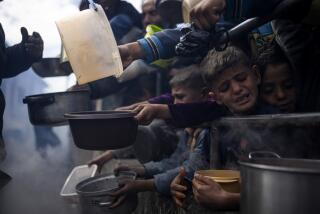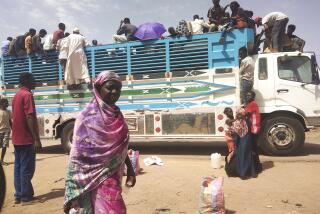COLUMN ONE : Somalia--Anatomy of a Famine : The more starvation progresses, the harder it is to treat. That mirrors the condition of Somalia where odds mount against recovery. Again, famine is shown to be a man-made, not natural, phenomenon.
The drought had passed over Abdi Husein’s farm. As recently as a year ago, he was able to grow corn, tomatoes and onions on four acres along a wadi flowing intermittently into the Juba River 150 miles from this provincial center.
But then the war reached his village. The army of deposed dictator Mohamed Siad Barre was fleeing west toward the Kenya border, pursued by the warlord Gen. Mohammed Farrah Aidid, and its path was left a wasted ruin.
“I had plenty stored,” said Husein, an exhausted wreck whose body made a faint indentation on a flimsy hospital bed. “But they grabbed all my food and collected all my animals and personal belongings.” Siad Barre’s men burned his village and moved on.
With his wife, daughter and six sons, Husein made his way to Doblei, the nearest town, eating wild fruits and leaves and gnawing on animal skins. The children died, some from gunfire during the battle, some from hunger. In Doblei, Husein got weaker and sicker, before they heard a rumor that food was coming into Bardera.
His family had reached Bardera eight days earlier by donkey cart. There was food but not much--only emergency rations suited mostly for dying children and protein biscuits with the consistency of sand.
Husein’s journey reflects the ghastly progress of his country. Somalia is gripped by a famine that has gone too far to be easily alleviated, just as Husein’s body is too impaired to gain nourishment from the food he is finally receiving.
Famine and hunger work in parallel. Starvation destroys the body’s ability to absorb nutrients; the further it progresses, the harder it is to treat. Famine is caused by and--in turn--exacerbates the breakdown in market mechanisms that make food available and affordable; the longer the delay in addressing these problems, the harder it is to return the economy to health.
The result is a vicious circle at each level, communal and individual.
Examining these twin processes tells much about how famines develop and how they affect communities and individuals. The lessons are important because explaining how Somalia reached the edge of oblivion and tipped over underscores the importance of early response to developing famines.
Because emergency food is only now arriving in the country where the prospect of famine was first identifiable a year ago, more than 1.5 million Somalis now face starvation, out of a total population estimated at more than 6 million. Hundreds of thousands may already have died. But travel into the Somali interior is still so hazardous that no one can even guess at the real figure.
The current Somali crisis dates to August, 1991, the beginning of the hunger season in the Horn of Africa. In this region, as over much of the continent, farmers are precariously dependent on one major rain-fed growing season a year. There is little natural irrigation. If the crop is poor--say 70% of normal--there may still be enough food to last until spring. But if there have been two or three droughts in a row, the farm regions will be in trouble.
In Somalia, an area of endemic drought, the population long ago developed what relief specialists call “coping mechanisms” for unreliable rainfall and harvests. Half the population are nomadic herders; they simply move their animals on to greener pastures. Farmers bury their own surplus as a cushion against lean years. But in 1991, in the words of Paul Mitchell, an official of the U.N. World Food Program, “everything that could go wrong did go wrong.”
In general, the relationship between drought and famine is widely misunderstood. Droughts often set off famines, but there is nothing about droughts that make famines inevitable; India has a drought in some region or other almost every year but has not had a famine death since the late 1950s.
Famine is not a natural phenomenon but a man-made one.
“Drought doesn’t kill people, politics does,” said William Garvelink, a disaster specialist involved in Somalia relief for the U.S. Agency for International Development (AID).
Famine can be created by misguided government policies that restrict the movement of food or disturb traditional practices.
In Ethiopia in the 1980s, Mengistu Haile Mariam’s regime required that all agricultural surplus be turned over to the state for sale--at fixed prices. Farmers were denounced as hoarders just for following the traditional practice of storing grain.
Transporting grain across provincial lines was illegal; Mengistu showed his disdain for the country’s agricultural traders--the middlemen who kept the grain flowing--by having many of them shot as speculators.
When drought struck the country’s north in 1983, there was little available farm surplus and no way to move it from thriving regions to dry ones. The result was the epic famine of 1984-85.
In Somalia, in 1991-92, civil strife and government collapse played the role that government interference did in 1980s Ethiopia. The factional fighting that followed Siad Barre’s ouster restricted the nomads’ movement, trapping them in waterless locations where their herds died. Fighting drove farmers off their land, separating them from their stocks and undermining crop output.
In past years, authorities could have responded to localized hunger by moving grain in or importing food from abroad, as is being done in Zambia and Zimbabwe, southern African countries hit this year by an unprecedented drought. But with Siad Barre’s departure, there was no longer any government in Somalia.
As famines go, the contribution made by civil strife is becoming less the exception than the rule. World Food Program figures show that in 1963, the dawn of Africa’s independent era, 70% of all worldwide emergencies to which it responded were natural disasters. Droughts, earthquakes and floods may be devastating, but assisting their victims is a relatively straightforward job.
But by 1988, the ratio had turned: 75% of emergencies were man-made, involving civil war and strife. In the same period, the length of the average emergency had grown from 18 months to 4 1/2 years, reflecting the greater difficulty of resolving human conflicts.
“I find an incredible explosion of disasters around the world,” Jan Eliasson, the newly appointed U.N. undersecretary general for humanitarian affairs, said this week in the midst of a tour that would take him from Somalia to southern Sudan, the scene of another civil war-inspired food crisis, to Zimbabwe.
Africa accounts for most of that change; the sub-Saharan region now consumes as much as 80% of the world’s emergency resources. These are mostly spent in places like Mozambique, Angola and Liberia, scenes of long civil wars. Africa’s emergency food needs have grown from 1.1 million tons in 1988 to 7.1 million tons this year.
The proliferation of civil strife means relief agencies are being forced to learn how to respond and function in a completely new world, much less straightforward than before.
“What has become extremely problematic in the past three years is how to deal effectively and deliver relief in a civil-strife emergency,” said Jamie Wickens, chief relief officer for the World Food Program.
Somalia will certainly be lesson No. 1.
In early 1991, as its civil war intensified after Siad Barre’s flight, the United Nations and the country’s traditional donors, chiefly the United States, had evacuated all their personnel for safety.
Satellite technology can help produce estimates of crop size and rainfall patterns--and painted a frightening picture of Somalia’s prospects in mid-1991--but only on-the-ground surveillance can reveal such critical factors as a population’s nutritional state. In mid-1991, a few Red Cross volunteers and others from small relief groups remained in Mogadishu and other towns, but their ability to see and assess conditions in the interior was nonexistent.
“We’re only now getting assessments from rural areas,” Mitchell said. This turned out to be crucial because rainfall was not the critical factor in Somalia’s agricultural collapse. As Wickens noted: “It wasn’t lack of rainfall, but local and rural populations so uprooted (by war) that people were not able to farm.”
As the government collapse and internecine strife depopulated Somalia’s farms, its population of refugees and the displaced swelled to more than 1 million. They collected in towns or makeshift camps, swiftly overwhelming whatever water supplies or sanitation might have existed. To relief agencies, this is always the point of no return. “Once the population starts moving, you’ve essentially lost the battle,” said AID’s Garvelink.
It is in such camps that the individual toll of starvation becomes apparent. In one of 36 feeding kitchens established by the International Committee of the Red Cross in the industrial zone of the capital, Mogadishu, 2,500 displaced persons have gathered. The entire compound has a sound balefully familiar to doctors working in famine zones.
“When I walk through feeding centers, the auditory clue is I don’t hear much laughing or playing by children but a lot of coughing,” said Dr. Daniel Miller, an epidemiologist at the U.S. Centers for Disease Control now assigned to AID’s Somalia relief team.
These are signs of two effects of starvation. One is lethargy; the other is a deterioration of the immune system, which abets the spread of such opportunistic diseases as tuberculosis and measles.
Among the 1,000 children in this center is Abdi Rissak Abdi Ahmed. He is a 7-year-old the size of a 2-year-old. He sits rigid and oblivious at the feet of his father, who explains that even the fortified Red Cross food being ladled out to the people is no use; the child will not eat.
Children are especially vulnerable to protein and caloric deprivation, Miller noted. Malnutrition attacks the body’s fastest-growing cells, among them the hair and the gastrointestinal system. Like many children at the feeding center, Abdi’s hair is soft, thin and slightly orange. That, plus his emaciation and his listless and unresponsive face, are signs of marasmus, the caloric deficiency that is the most common form of malnutrition in Somalia.
As Miller says, the effects of starvation can be interpreted as the body’s attempt to conserve its diminishing mass. Body temperature and pulse rate drop as the metabolism slows; the resulting lethargy conserves energy.
Eventually, the body begins to consume itself, burning muscle mass and shutting down systems in a desperate attempt to preserve three organs: the heart, brain and kidneys.
Abdi’s stunted growth is characteristic. Children stop growing until they are fed again; the lost growth time is never regained, often showing up as a permanent deficiency in intellectual capacity.
In this camp, as in most others, infectious diseases are rampant. Among the most devastating is measles. In healthy children, this disease is almost innocuous, but in malnourished ones it is a killer. The United Nations Children’s Fund has recently announced plans to immunize 1 million Somali children against measles. But in Mogadishu and other famine centers in Somalia, the disease is already epidemic.
The other major killer is diarrhea, much of it caused by parasites in unsanitary water consumed by residents of refugee and displaced-person camps.
But sometimes the cause is feeding the malnourished. Because starvation attacks the gastrointestinal system, those being fed for the first time after a long period experience “dumping syndrome”--nutritious oils and fats get passed right through the intestinal tract, contributing to a dehydration that can kill children.
The digestive system damage is also what makes children who have reached Abdi’s advanced stage of starvation so hard to treat; they vomit anything they eat, and eventually their lethargy and apathy make them refuse all food. In the absence of intravenous feeding--impossible in a place like this--death is inevitable.
In the Bardera hospital compound where the farmer Husein lies dying, 600 people are gathered for their turn to be fed. They sit in the dirt, flanked by a cadre of suspicious guards and viewed with condescension by Col. Mohamed Gelle, one of Aidid’s officers, who has a pistol strapped into a belt holster of red leather.
Another 200 people mass in front of the compound’s sheet-metal gates, brandishing bowls at men wielding sticks to keep them from invading the feeding center out of turn.
The center had three days’ rations left, said Dr. Mohamed Kulai Mohamed, its director. In ideal circumstances, there would be cornmeal, beans and cooking oil for the adults and a fortified gruel, called W-mix, for the children. But all that arrived in town from the sporadic flights of German military cargo planes was W-mix. So everybody gets that, although it is not strong enough to keep adults nourished.
Mohamed distributes 3,000 meals a day, but only rarely does the food hold out long enough to feed everyone coming to the hospital. As he talks, there is a signal, and the crowd stampedes across the dirt to the caldrons bubbling at one end. The weakest and slowest bring up the rear.
“Some people will not get fed,” Gelle observes.
In most cases, famine is not synonymous with an absolute scarcity of food. Less than half a mile from the hospital is Bardera’s main market, where camel meat hangs in raw strips from iron hooks, with parts of the animals--a head and neck here, two forelegs there--propped up in front, as if to advertise the wares. Sorghum and maize could be had by the sack or bowlful.
“You can often have a lot of food around in these cases but (at) high prices,” said Fred Cuny, an experienced relief expert working on a U.S.-financed relief project for the Somali famine. If one regards markets as an economic mechanism to bring buyers and sellers together to trade at a price advantageous to both, he said, “famine is a region-wide failure of markets.”
The principle has been set forth by economist Amartya Sen in the term “entitlements.” According to Sen, every household’s entitlement is what can be bought by its members’ labor, the crops they grow or the goods they make. In areas as marginal as rural Somalia, a family’s entitlement--in this case, enough food to sustain life--can be suddenly put out of reach, even amid abundance.
“So many people in this part of Africa live so close to the edge they can be kicked over it quite easily,” said the World Food Program’s Mitchell. “All it takes is the loss of a draft animal, a son or a drought.”
In Somalia’s case, drought and civil war conspired to destroy the entitlements of millions. As agricultural production fell and prices began to rise, merchants stockpiled as much food as they could find or steal, removing from the market whatever resources existed. This drove prices even higher and encouraged even more hoarding.
The end result is a picture like Bardera: Townspeople still have enough money to buy food in the market, even if their cash buys less than it did. But rural subsistence farmers, who are flocking to the feeding centers, lack the wherewithal to buy what they need.
In some countries, relief agencies and local governments have tried establishing strategic food reserves to keep prices from inflating; the World Food Program is helping Sudan establish a 75,000-ton reserve. But such foresight is rare and difficult to maintain in cash-strapped Third-World states.
The World Food Program has had no better luck maintaining an international reserve for quick response to local crises. Its 500,000-ton grain reserve facility has been empty for three years, in part because Western governments were loath to give the United Nations a free hand over so large a relief bank. “Donors want more and more to direct aid themselves,” Mitchell said.
But if merchants had heard a year ago that large amounts of free food would soon be arriving in Somalia, they would have had less reason to stockpile supplies and more incentive to release goods into the marketplace, lest their prices be undercut.
The opposite happened. As the retail price of wheat more than quadrupled, for example, merchants held it off the market, waiting for even higher prices. Food got out of the reach even of Somalis with money or crops to trade for it.
As in most famines, once food began arriving, those prices came down almost as fast as they rose. In Bardera, rice dropped to the equivalent of $3,000 per ton from $15,000 almost with the arrival of the first relief plane in mid-August.
But when a famine is permitted to progress as far as Somalia’s, relief efforts may continue to undermine the recovery of markets.
The kind of food destined for emergency delivery to Somalia--in bulk, with a long shelf life--is perfect for hoarding. In the country’s near-nonexistent economy, it has value as currency--in fact, it is more stable than Somali currency. That is why it is so heavily looted that less than half may be reaching the neediest victims.
This is just one more example of how a late international response to the Somali famine allowed it to spin out of control.
“People knew what was happening and agencies were issuing warnings, but it didn’t capture political or public attention until too late,” Mitchell said. “Wherever you get a situation like this, where donors are just responding now to the need, forget it.”
More to Read
Sign up for Essential California
The most important California stories and recommendations in your inbox every morning.
You may occasionally receive promotional content from the Los Angeles Times.






